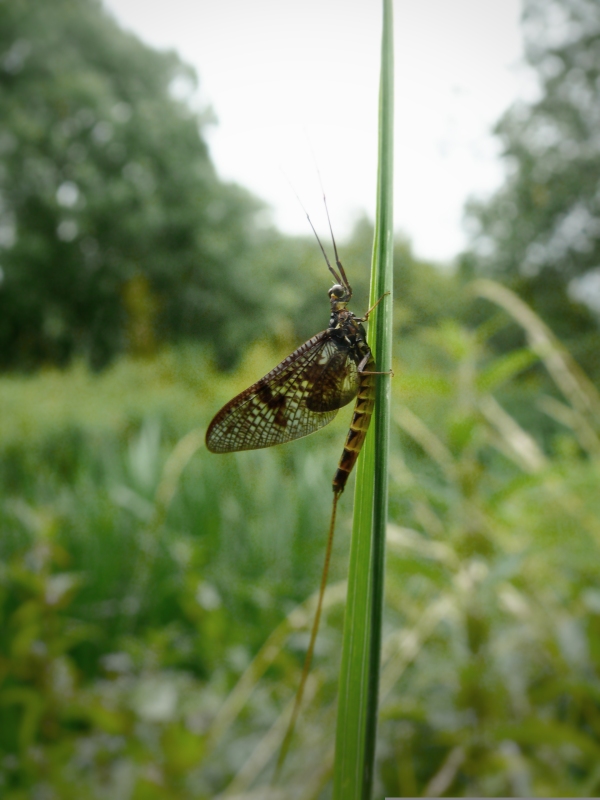A glow-in-the-dark limpet, a fierce-looking 'toe-biter' (which isn't fierce at all and would scarper at first sniff of your toe) and a mayfly that lacks a functioning mouth (and, not-surprisingly, lives as an adult for only a few days) are just some of the weird and wonderful critters to be found in New Zealand's 425,000 kilometres of streams and rivers.
Our freshwater fauna are wonderfully diverse and, according to NIWA Freshwater Ecologist Dr Richard Storey, there's nothing among them that we need to be afraid of.
"You can find a suitable stream, wade in, turn over rocks and explore amongst the plants and plant debris, safe in the knowledge that none of our stream-dwelling critters will hurt you. It's a fabulous way to spend a summer's day."
Dr Storey says that New Zealand has several hundred freshwater invertebrate species, and 13 genera (a higher classification level than species) form a common group that can be found right across the country. Here's a quick look at some of the more quirky among them:
The koura, or freshwater crayfish, is probably our best-known stream-dwelling invertebrate. A koura grows to between five and ten centimetres long and can be quite difficult to spot, as it hides out among logs and other plant matter on the stream edges.
"If you investigate underneath rocks, leaf litter and tree fern fronds, you'll probably find one," says Dr Storey. "And if you have the chance, try exploring by torchlight at night. That's when koura are most active, and their eyes shine bright blue when the light catches them."
That glow-in-the-dark quality is shared by the tiny freshwater limpet (Latia neritoides), which activates an in-built warning system when disturbed. "It excretes a luminous mucus, designed to put off predators, that glows green in the dark," says Dr Storey.
The limpet grows to a mere 12 millimetres long and is vulnerable to swift currents, so prefers to spend its time feeding on bacteria and other 'biofilm' living on rocks in warm, slow-flowing water. For that reason, it is more common in the north.
"And while we're on the subject of creatures that glow, let's not forget the beautiful glow-worm. They're not actually worms at all, but larvae of the rather unfortunately named fungus gnat (Arachnocampa luminosa). They're quite common, so if you're out exploring at night you might be lucky enough to spot some on banks overhanging streams. The water keeps them cool and moist."
The glow-worm's blue-green light is produced by chemical reactions in a kidney-like organ common to all insects. The glow-worm has the unique ability to produce light, which is used to attract food and a mate.
If creepy-crawlies of the more substantial variety are your thing, you can't go past the centipede-like toe-biter (Archichauliodes diversus), one of our largest aquatic insects.
"It derives its common name from its rather threatening-looking pincers, but in fact it's completely harmless to us," Dr Storey says. "It has finger-like gills running down its back, which make it look like a centipede – but in fact it has only six legs, like any other insect. At five centimetres long, it is one of our more impressive stream-dwellers. You should be lucky enough to find one by turning over rocks in the stream."
That's also the habitat of the mayfly – a small, three-tailed insect that has a flattened body shape and uses its gills like an aerofoil to stay stuck to submerged rocks, where it feeds on algae.
The poor adult Deleatidium spp., our most common mayfly, doesn't enjoy much luxury in life. "After spending a year as larvae, it hatches without a functioning mouth or any other means of ingesting food," explains Dr Storey. "Its sole purpose as an adult is to mate and lay eggs – a process that takes one to three days – and then it dies. That's life pared back to the bare basics!
"You may remember a Vodafone TV advertisement from a few years ago that used a cartoon mayfly to communicate the company's 'make the most of now' slogan – very appropriate!"
The caddisfly is another commonly found freshwater resident. Two types are seen in New Zealand. One lives in a slightly curved, stick- or stone-like case. The stick caddis fools would-be predators into thinking it is a twig. The stony caddis uses its heavier case as an anchor so it can live and feed in faster-flowing water. The other type is free-living, making its home in leaves and other loose material at the base of rocks.
"Some free-living caddisflies spend their time building a net-like structure, something like a spider's web, which catches floating fragments of leaf and other morsels it can feed on," Dr Storey explains. "It periodically scuttles out to feed and clear any unwanted debris, then returns to the safety of its 'house'."
The caddisfly is closely related to the caterpillar. "The adult looks like a moth, because it almost is."
Dr Storey has been investigating these and other fascinating freshwater creatures since the age of nine, when his interest in freshwater ecology sparked. He has now spent close to 20 years – the last eight with NIWA – getting to know the myriad invertebrates that call New Zealand's streams and rivers home.
"There's so much still to be discovered," he says. "That's the exciting thing. I encourage young and old to get out there and see what they can find. It really is an amazing world."


